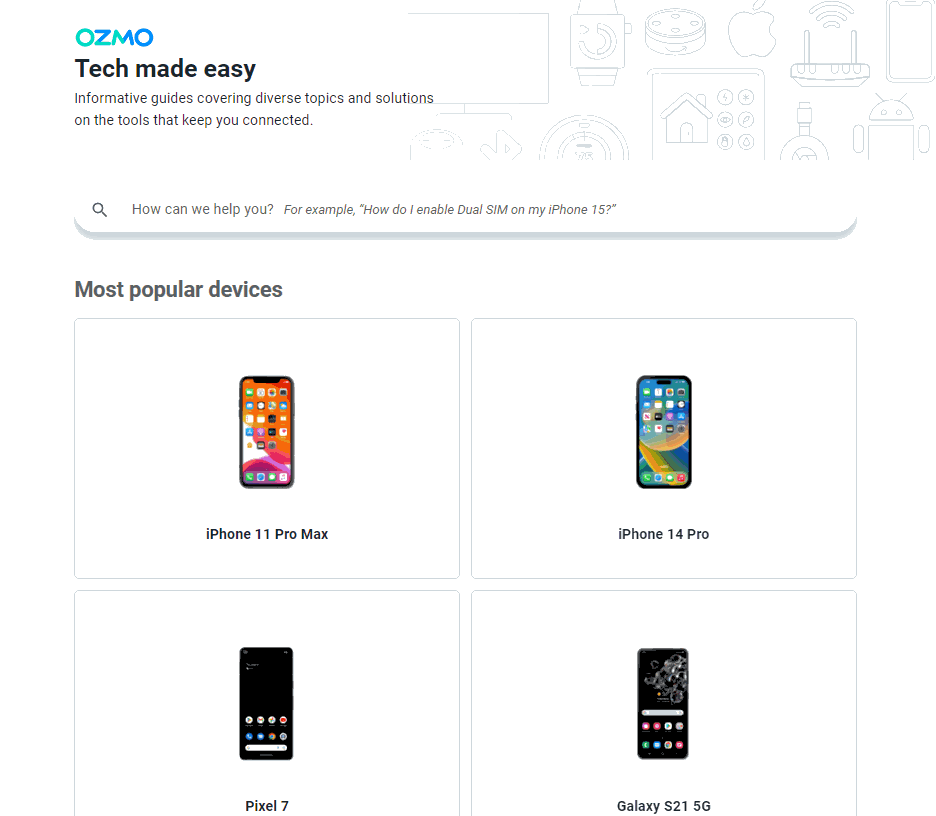Introducing the second installment of Ozmo's holistic support series. In our first article, we covered proactive customer service and the importance of educating customers as they get started and throughout their entire user journey.
Now we’re shifting our focus to another component of holistic support: customer self-serve, which is all about providing the right answer for your customers at the right time.
In this article, we’ll dive into the significance of self-serve tech support, a key tool for service providers aiming to enhance customer satisfaction and reduce operational costs. Let’s get started.
What is customer self-serve?
Self-serve support empowers customers to resolve issues independently, increasing call deflection and reducing truck rolls.
It revolves around delivering accurate, up-to-date information through preferred customer channels, ensuring solutions are accessible when needed. This model is similar to the self-checkout at grocery stores or kiosks at airports, offering convenience and efficiency.
A robust self-serve strategy should be omnichannel, providing consistent, accurate answers across all customer touchpoints. Customers expect quick resolutions, regardless of the channel they use. An effective omnichannel approach ensures seamless support experiences, catering to different learning preferences — whether through articles, videos or interactive guides.
The current landscape of self-serve tech support
With 81% of all customers attempting to resolve issues on their own before contacting a live representative, the need for self-serve options is clear. But, despite its advantages, the current state of self-serve tech support could be better.
Many service providers offer some form of self serve, but the quality and consistency of answers can vary greatly. Inconsistencies across channels, outdated content and difficult-to-find support resources are common.
The benefits for customers and enterprises
Self-serve tech support offers several benefits for both customers and enterprises. For users, it means shorter wait times, the ability to troubleshoot at their own pace and reduced frustration, especially for those who prefer minimal human interaction.
On the other hand, enterprises enjoy significant cost savings by deflecting calls from their support centers or costly truck rolls. For example, most companies save between $6 to $20 per deflected call, which can add up significantly when supporting millions of customers. A great example of this is Verizon, which used Ozmo’s self-serve solutions to boost its call deflection rate to 85%, leading to millions of dollars in cost savings each year.
Customer self-serve strategies
To meet the high expectations of today’s customers, self-serve options must be fast and effective. Speed is crucial, as 90% of customers expect an immediate response when seeking support. However, current challenges in customer self-serve include outdated content, lack of personalization and poor findability. These issues not only frustrate users but also negatively impact customer satisfaction and loyalty.
These strategies can help you overcome these challenges and level up your self-serve solutions.
Provide easy-to-find answers
Ensure customers can quickly locate the information they need, enhancing their self-serve experience. Organize self-serve support answers in a user-friendly, searchable knowledge base with clear categories, intuitive navigation and a reliable search function to guarantee easy accessibility.
Keep content up-to-date and accurate
Regularly update your support content to maintain accuracy and relevance, improving customer satisfaction. Accurate, current information helps customers quickly resolve issues, reduces support tickets and boosts overall trust in your brand.
Provide an option for assisted support
Offer a seamless transition to assisted support for complex issues that cannot be resolved through self-service alone. Customers should never feel like they aren’t able to speak with an agent if they aren’t finding the right answers on their own.
Measure self-serve performance
Track the utilization and effectiveness of your self-serve options. Utilization data indicates if the content is accessible and being used, while effectiveness is measured by the resolution rate, showing how many users solve their problems independently. High resolution rates lead to significant call deflection, reducing costs and increasing efficiency.
Self-serve options in modern tech support
As customers increasingly turn to online channels, companies are expanding self-serve options to handle ticket volume and satisfy the demand for 24/7 support. Here are some examples of effective self-service solutions.
Knowledge bases
A knowledge base is a hub for all of the useful resources about your products and services. It usually includes articles, video tutorials and how-to guides. These help centers let customers quickly find answers to common issues on their own, whether they want to watch a video or click through an interactive guide. Plus, with good SEO, customers can easily find your knowledge base through Google.
Interactive tutorials
Many companies still rely on outdated FAQs and long text-based manuals, which can end up confusing customers more. Interactive tutorials are transforming self-service by guiding users through troubleshooting and maximizing product value. Available in formats like dynamic images and videos, these tutorials make customers active participants in their own support journey.
How to connect a Bluetooth device to an Ignite Entertainment Box
AI chatbots
AI chatbots are revolutionizing self-service tech support by offering quick, accurate responses and 24/7 availability. These intelligent assistants handle routine inquiries, freeing up human agents for complex issues. With natural language processing, AI chatbots provide personalized, efficient support, enhancing customer satisfaction and reducing operational costs for businesses.

Customer support interaction with an AI chatbot
Transform customer support with self-serve solutions
Effective self-serve tech support transforms customer experiences and drives significant benefits for enterprises. By ensuring fast, reliable and accessible support, businesses can enhance customer satisfaction, reduce costs and maintain loyalty.
As the landscape of tech support continues to evolve, investing in robust self-serve solutions will be key for staying competitive and meeting the growing demands of tech-savvy consumers.

Are you interested in providing timely, accurate self-serve content that integrates seamlessly into various support experiences? As a leader in omnichannel customer service, Ozmo is trusted by Verizon, Rogers, TELUS and more. Learn more about how Ozmo’s omnichannel platform can help your business.



